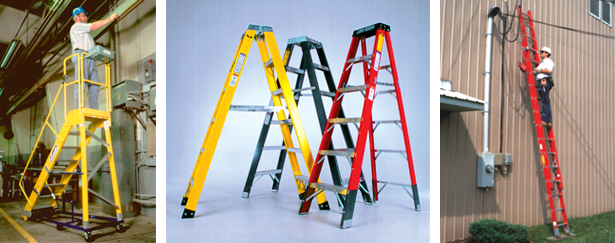Five Topics for Ladder Safety Month

According to OSHA, falls are the second leading cause of occupational injuries (after highway crashes). On a monthly basis, almost 60 people in the United States succumb to injuries related to improper use of ladders. As one of the leading global producers of fiber reinforced polymer (FRP) ladder rails, our products are used in both commercial and consumer grade ladders. Strongwell always emphasizes safety, design, and educational precautions when utilizing ladders. As a part of national Ladder Safety Month, Strongwell would like to share five tried and true topics on ladder safety that will help you stay safe and avoid falls.
Choosing the Right Ladder
Ladders are built for elevation and reach. Did you know that not all ladders are designed for the same tasks? Always review the directions on a ladder prior to use. Below are four guiding questions to help with the selection of a ladder.
• What is the height of your project?
• Are there any weight limitations for the ladder?
• Is it an outdoor or indoor job?
• Will there be any exposure to electricity?
Equal Footing
Ladders need stability. Consider these seven tips to ensure your ladder has a good footing.
• Soft surfaces can detract from the stability of a ladder’s footing. Ensure there are stable points of contact for all legs of a ladder. Pro Tip: Use a solid board under the feet to offer additional stability.
• Never lean an extension or straight ladder against an unstable or uncertain surface, such as a window pane.
• Think 4 to 1. A straight or extension ladder should be placed 1 foot away from the resting surface for every four feet of the ladder height. For example, an eight foot ladder should extend two feet away from the resting surface.
• Always secure a straight or extension ladder to an upper support.
• Step ladders should always be fully opened prior to climbing.
• If a ladder is within a doorway, ensure that signage is available to warm individuals of a work area.
• Never place a ladder on any object other than stable flooring to secure additional height.
Understanding the Risk of the Climb
Individuals who frequently use ladders risk becoming complacent about their safety. Below are some tips for ensuring a safe climb.
• Always face the ladder when climbing and grip the rungs – never the side rails
• Think three! Maintain three points of contact with the ladder: two feet and one hand or two hands and one foot.
• Never depart a ladder from the side.
• A ladder should extend at least three feet off the roof or platform you are trying to reach. This ensures that both the rest and foundation points have stable surfaces for contact.
Climb with Caution
Never overreach or lean on a ladder, as this creates a shift from the center of gravity. Always reposition the ladder when you are out of reach. The following three tips ensure best climbing practices.
• Never climb while carrying tools – utilize a tool belt to ensure three points of contact at all times.
• Rungs can get slippery under certain conditions. Ensure that the soles of your shoes are slip resistant.
• Ladders have a weight limit. Ensure that only one individual is on a ladder at a time.
Consider the Environmental Conditions
People should never risk safety when it comes to outdoor ladder usage. The four tips below provide best outdoor ladder usage practices.
• Always check the weather forecast prior to using a ladder in any outdoor environment.
• Never use an extension ladder in windy or unfavorable weather.
• Always remove yourself and others from ladders when bad weather is approaching.
• Proper maintenance of a ladder is key to maintaining peak performance. Ensure that ladders are clean, dry, and functional prior to use.
Want to learn more about ladder safety? Below are three useful resources on ladder safety.
American Ladder Institute
https://www.americanladderinstitute.org/default.aspx
OSHA Standard for portable ladders contains specific requirements designed to ensure worker safety
https://www.osha.gov/SLTC/etools/construction/falls/4ladders.html
National Safety Council Injury Safety Statistics
https://injuryfacts.nsc.org/